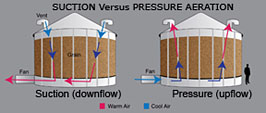This page has been archived and is being provided for reference purposes only. The page is no longer being updated, and therefore, links on the page may be invalid.
|
|
|
|
Better Insect Control When Air is Pulled Down through Grain Bins
By Jan SuszkiwAugust 23, 2010
Aeration—blowing ambient air through grain storage bins—has been used for decades to maintain the quality of grain by keeping it cool, as well as to manage stored insect pests. But few recent studies have examined whether it's better to direct air from above or below as a means of using temperatures of 60 degrees Fahrenheit or below to control insects.
To find out, U.S. Department of Agriculture (USDA) entomologist Frank Arthur and agricultural engineer Mark Casada experimented with storage bins whose grain masses were cooled with either pressure aeration or suction aeration. Pressure aeration uses fans to push ambient air from the bottom of the bin upwards, while suction aeration involves reversing the fans to pull air from the top downward.
Arthur and Casada work at the Agricultural Research Service (ARS) Center for Grain and Animal Health Research in Manhattan, Kan. ARS is USDA's chief intramural scientific research agency.
The researchers conducted two eight-month trials using six metal storage bins with perforated floors and grain storage capacities of 1,250 bushels of wheat. Stored insects examined in the study were rusty grain beetles, foreign grain beetles, hairy fungus beetles, red flour beetles, saw-toothed grain beetles, rice weevils and lesser grain borers.
The data showed that, during the summer, suction aeration cooled the stored wheat's upper portion, or "surface zone," more quickly than pressure aeration, and that the difference correlated to fewer insect pests. For example, in pressure aeration-cooled bins, 3,290 rusty grain beetles and 8,210 red flour beetles were found in surface-zone traps, versus 662 and 722 respectively in suction aeration-treated bins.
Suction aeration's rapid cooling of the grain's surface zone is advantageous because that's where insects initially infest the grain after flying in from outside, according to Arthur.
Larger-scale studies are needed. But one expected benefit to using suction aeration could be reduced reliance on the fumigant phosphine to control insects.
The research, published in the journal Applied Engineering and Agriculture, supports the USDA priority of promoting international food security.

